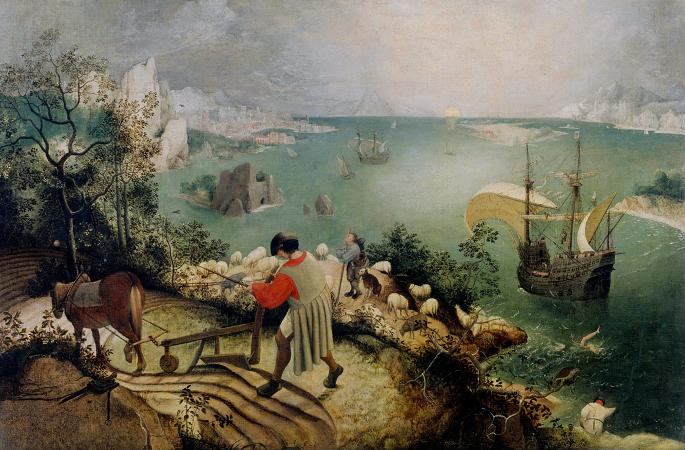Jan Brueghel the Elder (1568 - 1625). Jan Brueghel the Elder was a Flemish painter and draughtsman. He was the son of the eminent Flemish Renaissance painter Pieter Brueghel the Elder. A close friend and frequent collaborator with Peter Paul Rubens, the two artists were the leading Flemish painters in the first three decades of the 17th century. Brueghel worked in many genres including history paintings, flower still lifes, allegorical and mythological scenes, landscapes and seascapes, hunting pieces, village scenes, battle scenes and scenes of hellfire and the underworld. He was an important innovator who invented new types of paintings such as flower garland paintings, paradise landscapes, and gallery paintings in the first quarter of the 17th century. He further created genre paintings that were imitations, pastiches and reworkings of his father's works, in particular his father's genre scenes and landscapes with peasants. Brueghel represented the type of the pictor doctus, the erudite painter whose works are informed by the religious motifs and aspirations of the Catholic Counter-Reformation as well as the scientific revolution with its interest in accurate description and classification. He was court painter of the Archduke and Duchess Albrecht and Isabella, the governors of the Southern Netherlands. The artist was nicknamed Velvet Brueghel, Flower Brueghel, and Paradise Brueghel. The first is believed to have been given him because of his mastery in the rendering of fabrics. The second nickname is a reference to his specialization in flower still lifes and the last one to his invention of the genre of the paradise landscape. His brother Pieter Brueghel the Younger was traditionally nicknamed de helse Brueghel or Hell Brueghel because it was believed he was the author of a number of paintings with fantastic depictions of fire and grotesque imagery. These paintings have now been reattributed to Jan Brueghel the Elder. Jan Brueghel the Elder was born in Brussels as the son of Pieter Brueghel the Elder and Maria Coecke van Aelst. His mother was the daughter of the prominent Flemish Renaissance artists Pieter Coecke van Aelst and Mayken Verhulst. His father died about a year after Jan's birth in 1569. It is believed that after the death of his mother in 1578, Jan, together with his brother Pieter Brueghel the Younger and sister Marie, went to live with their grandmother Mayken Verhulst, who was by then widowed. Mayken Verhulst was an artist in her own right. The early Flemish biographer Karel van Mander wrote in his Schilder-boeck published in 1604 that Mayken was the first art teacher of her two grandsons. She taught them drawing and watercolor painting of miniatures. Jan and his brother may also have trained with local artists in Brussels who were active as tapestry designers. Jan and his brother Pieter were then sent to Antwerp to study oil painting. According to Karel van Mander he studied under Peter Goetkint, an important dealer with a large collection of paintings in his shop. Goetkint died on 15 July 1583 not very long after Jan had started his training. It is possible that Jan continued his studies in this shop, which was taken over by Goetkint's widow, as no other master is recorded. It was common for Flemish painters of that time to travel to Italy to complete their studies. Jan Brueghel left for Italy, first traveling to Cologne where his sister Marie and her family lived. He later visited Frankenthal, an important cultural centre where a number of Flemish landscape artists were active. He then went to Naples after probably spending time in Venice. In Naples he produced after June 1590 a number of drawings, which show his interest in landscapes and monumental architecture. He worked for Don Francesco Caracciolo, a prominent nobleman and priest and founder of the Clerics Regular Minor. Jan produced small-scale decorative works for Don Francesco. Brueghel left Naples for Rome where he resided from 1592 to 1594. He befriended Paul Bril. Paul Bril was a landscape specialist from Antwerp who had moved to Rome in the late 16th century. Together with his brother Mathijs Bril, he created atmospheric landscapes for many Roman residences. Brueghel took inspiration from Bril's lively drawings and small-scale landscapes of the mid-1590s. During his time in Rome Jan Brueghel became acquainted with Hans Rottenhammer, a German painter of small highly finished cabinet paintings on copper. Rottenhammer painted religious and mythological compositions, combining German and Italian elements of style, which were highly esteemed. Brueghel collaborated with both Paul Bril and Rottenhammer. Brueghel also spent time making watercolors of Rome's antique monuments and seemed particularly fascinated by the vaulted interiors of the Colosseum.
more...














